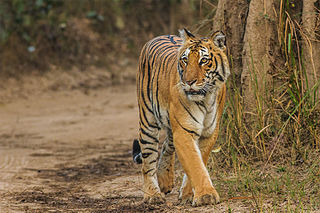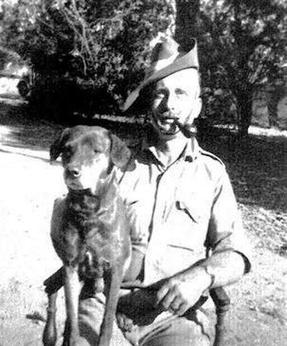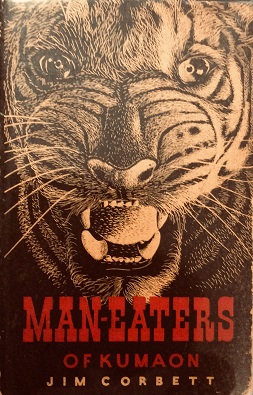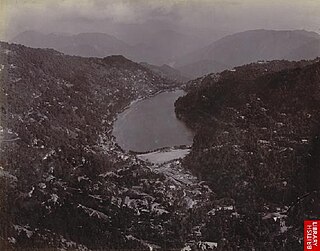This article relies largely or entirely on a single source .(June 2015) |

The Leopard of Rudraprayag was a male man-eating leopard, reputed to have killed over 125 people. It was eventually killed by hunter and author Jim Corbett.
This article relies largely or entirely on a single source .(June 2015) |

The Leopard of Rudraprayag was a male man-eating leopard, reputed to have killed over 125 people. It was eventually killed by hunter and author Jim Corbett.
The first victim of leopard was from Benji Village, and was killed in 1918. For the next eight years, people were afraid to venture alone at night on the road to the Hindu holy shrines of Kedarnath and Badrinath, for it passed through the leopard's territory, and few villagers left their houses after dark. The leopard, preferring human flesh, would break down doors, leap through windows, claw through the mud or thatch walls of huts and drag the occupants out before devouring them.[ citation needed ] According to official records, the leopard killed over 125 people. However, Corbett notes that the number of deaths was probably higher due to unreported kills and deaths due to injuries sustained in attacks.
Units of Gurkha soldiers and British soldiers were sent to track it, but failed. Attempts to kill the leopard with high powered gin traps and poison also failed. Several well-known hunters tried to capture the leopard and the British government offered financial rewards. All of this, however, ended in failure. In the autumn of 1925, Jim Corbett took it upon himself to try to kill the leopard and, after a ten-week hunt, he successfully did so on 2 May 1926.
Corbett's notes revealed that this leopard, a large elderly male, was in fine condition except for a few healed injuries sustained from hunters after it had become a man-eater. The leopard had started hunting people eight years earlier, when it was still young; therefore it was not old age that caused it to turn to hunting people. Corbett wrote that, in his opinion, human bodies left unburied during disease epidemics were the main reason for the Rudraprayag and Panar leopards to become man-eaters.
At the end of the introduction of his book Man-Eaters of Kumaon , Corbett wrote:
A leopard, in an area in which his natural food is scarce, finding these bodies very soon acquires a taste for human flesh, and when the disease dies down and normal conditions are established, he very naturally, on finding his food supply cut off, takes to killing human beings. Of the two man-eating leopards of Kumaon, which between them killed over five hundred and twenty-five human beings, one followed on the heels of a very severe outbreak of cholera, while the other followed the mysterious disease which swept through India in 1918 and was called war fever.
In Rudraprayag, there is a sign-board which marks the spot where the leopard was shot. There is a fair held at Rudraprayag commemorating the killing of the leopard.
The leopard was the subject of a 2005 BBC Two TV Series Manhunters , in the episode The Man-Eating Leopard of Rudraprayag, [1] which presents an entirely fictionalized representation of Jim Corbett's hunt.

Jim Corbett National Park is a national park in India located in the Nainital district of Uttarakhand state. The first national park in India, it was established in 1936 during the British Raj and named Hailey National Park after William Malcolm Hailey, a governor of the United Provinces in which it was then located. In 1956, nearly a decade after India's independence, it was renamed Corbett National Park after the hunter and naturalist Jim Corbett, who had played a leading role in its establishment and had died the year before. The park was the first to come under the Project Tiger initiative.

Kenneth Douglas Stewart Anderson was an Indian writer and hunter who wrote books about his adventures in the jungles of South India.

Edward James Corbett was an Indian-born British hunter, tracker, naturalist and author. He was frequently called upon by the Government of the United Provinces of Agra and Oudh to kill man-eating tigers and leopards that were attacking people in the nearby villages of the Kumaon and Garhwal Divisions. He recounted his hunts and experiences in books like Man-Eaters of Kumaon, which enjoyed critical acclaim and commercial success. He was also an avid photographer and spoke out for the need to protect India's wildlife from extermination.

The Tsavo Man-Eaters were a pair of large man-eating male lions in the Tsavo region of Kenya, which were responsible for the deaths of many construction workers on the Kenya-Uganda Railway between March and December 1898. The lion pair was said to have killed dozens of people, with some early estimates reaching over a hundred deaths. While the terrors of man-eating lions were not new in the British public perception, the Tsavo Man-Eaters became one of the most notorious instances of dangers posed to Indian and native African workers of the Uganda Railway. They were eventually killed by Lieutenant Colonel John Henry Patterson, who wrote his account of his hunting experience in a semi-biography The Man-Eaters of Tsavo.

Man-Eaters of Kumaon is a 1944 book written by hunter-naturalist Jim Corbett. It details the experiences that Corbett had in the Kumaon region of India from the 1900s to the 1930s, while hunting man-eating Bengal tigers and Indian leopards. One tiger, for example, was responsible for over 400 human deaths. Man-Eaters of Kumaon is the best known of Corbett's books, and contains 10 stories of tracking and shooting man-eaters in the Indian Himalayas during the early years of the twentieth century. The text also contains incidental information on flora, fauna and village life. Seven of the stories were first published privately as Jungle Stories.

Wolf hunting is the practice of hunting wolves. Wolves are mainly hunted for sport, for their skins, to protect livestock and, in some rare cases, to protect humans. Wolves have been actively hunted since 8,000 to 10,000 years ago, when they first began to pose a threat to livestock of Neolithic human communities. Historically, the hunting of wolves was a huge capital- and manpower-intensive operation. The threat wolves posed to both livestock and people was considered significant enough to warrant the conscription of whole villages under threat of punishment, despite the disruption of economic activities and reduced taxes. The hunting of gray wolves, while originally actively endorsed in many countries, has become a controversial issue across the globe. Most people see it as cruel, unnecessary and based on misconceptions, while proponents argue that it is vital for the conservation of game herds and as pest control.

The Champawat Tiger was a female Bengal tiger responsible for an estimated 436 deaths in Nepal and the Kumaon division of India, during the last years of the 19th century and the first years of the 20th century. She was shot and killed in 1907 by the 31-year-old Jim Corbett.

The Indian leopard is a subspecies of the leopard that is widely distributed on the Indian subcontinent and is threatened by illegal trade of skins and body parts, and persecution due to human-leopard conflict and livestock depredation. A national census of leopards around tiger habitats was carried out in India in 2014, except the northeast. 7,910 individuals were estimated in surveyed areas and a national total of 12,000–14,000 speculated.

The town of Nainital, India was founded in 1841 by P. Barron, a sugar trader from Shahjahanpur. By 1846 the church St John's in the Wilderness was founded and a hill station had begun to flourish. Among the authors who referred to Nainital in their writings were Rudyard Kipling, Premchand, and Jim Corbett. This page consists of references to Nainital in literature.
Manhunters was a three-part TV drama series that aired on BBC Two in the United Kingdom in 2005. It tells the story of three cases of man-eaters through the memoirs of those who hunted them and, in the case of the third episode, accidentally unleashed them on their community. The first tells the story of Jim Corbett, played by Jason Flemyng and the Man-Eating Leopard of Rudraprayag. The second tells the story of George Rushby and the Lions of Njombe, and the third tells the story of the Wolf of Gysinge.
A man-eater is an individual animal or being that preys on humans as a pattern of hunting behavior. This does not include the scavenging of corpses, a single attack born of opportunity or desperate hunger, or the incidental eating of a human that the animal has killed in self-defense. However, all three cases may habituate an animal to eating human flesh or to attacking humans, and may foster the development of man-eating behavior.

Tiger attacks are a form of human–wildlife conflict which have killed more humans than attacks by any of the other big cats, the majority of these attacks occurring in Bangladesh, India, Nepal and Southeast Asia.
The Leopard of the Central Provinces, also known as the Devilish Cunning Panther, was a man-eating male Indian leopard which over the course of a couple of years, killed over 150 people, all women and children, in the Central Provinces of British India in the early 20th century. The leopard reportedly claimed a victim once every 2–3 days, each time in a different area to the last, with the killings sometimes taking place 20–30 miles apart. The leopard caused such panic that the native communities in its range rarely left their homes alone or unarmed.
The Tigers of Chowgarh were a pair of man-eating Bengal tigers, consisting of an old tigress and her sub-adult cub, which for over a five-year period killed a reported 64 people in eastern Kumaon over an area spanning 1,500 square miles (3,900 km2). The tigress was attacking humans initially alone, but later she was assisted by her sub-adult cub. The figures however are uncertain, as the natives of the areas the tigers frequented claimed double that number, and they do not take into account victims who survived direct attacks but died subsequently. Both tigers were killed by Jim Corbett.
Raymond Sheppard was a British artist and illustrator of books for children and adults. He wrote books on drawing techniques, but is best known for his illustrations of Ernest Hemingway's 1952 novel The Old Man and the Sea and the works of Jim Corbett.
The Thak man-eater was a female Bengal tiger who killed and ate four human victims between September and November 1938. She was operating in Kumaon, at the Nepalese border, between the villages Thak, Chuka, Kot Kindri and Sem. The tigress was shot at about 6:00pm on 30 November 1938 by Jim Corbett. This was the last man-eater killed by Corbett. The story about the Thak man-eater is known as one of the most dramatic stories about man-eating animals. It was the last story in the USA edition of the bestselling book Man-Eaters of Kumaon. In the UK edition the last story of the book was "Just Tigers". The book Man-Eaters of Kumaon became the book of the year in USA in 1945, and a Hollywood film Man-Eater of Kumaon was made in 1948.
India: Kingdom of the Tiger is a 2002 IMAX feature documentary, inspired by the writings of Jim Corbett. The film was directed by Bruce Neibaur. It depicts man-eating tigers and the conservation efforts of the tiger in India.
The Chuka man-eating tiger was a male Bengal tiger responsible for the death of three boys from Thak village in the Ladhya Valley in 1937. It was shot by Jim Corbett in April 1937 who noted that the animal had a broken canine tooth and several gunshot wounds in various parts of his body.

The Bachelor of Powalgarh also known as the King of Powalgarh, was an unusually large male Bengal tiger, said to have been 10 feet 7 inches long. From 1920 to 1930, the Bachelor was the most sought-after big-game trophy in the United Provinces. British hunter Jim Corbett shot and killed the Bachelor in the winter of 1930, and later told the story in his 1944 book Man-Eaters of Kumaon.

Leopard attacks are attacks inflicted upon humans, other leopards and other animals by the leopard. The frequency of leopard attacks on humans varies by geographical region and historical period. Despite the leopard's extensive range from sub-Saharan Africa to Southeast Asia, attacks are regularly reported only in India and Nepal. Among the five "big cats", leopards are less likely to become man-eaters—only jaguars and snow leopards have a less fearsome reputation. However, leopards are established predators of non-human primates, sometimes preying on species as large as the western lowland gorilla. Other primates may make up 80% of the leopard's diet. While leopards generally avoid humans, they tolerate proximity to humans better than lions and tigers, and often come into conflict with humans when raiding livestock.